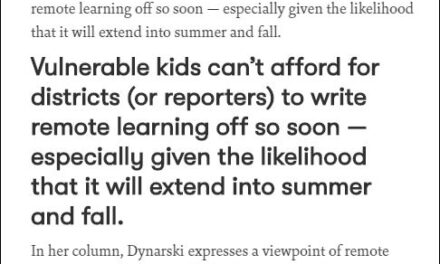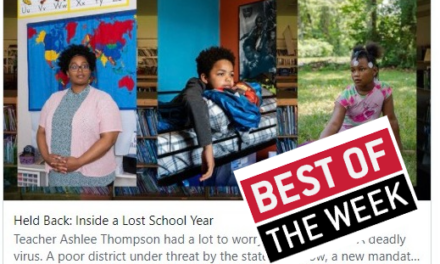.@lynnellhancock interviews Cara Fitzpatrick about her Pulitzer-winning series, Failure Factories. #equitymatters pic.twitter.com/XOqXA1pibF
— RenJournalism (@rjcmedia) June 3, 2016
On a rainy Friday morning in New York City not too long ago, a group of education reporters, foundation officials, and education experts gathered to talk about “the root causes and impact of our nation’s ever-widening ‘opportunity gap.’”
Hosted at the Ford Foundation, the Equity Matters Symposium featured presentations from the Tampa Bay Times’ Cara Fitzpatrick (above left), a member of the team that won the Pulitzer Prize for its investigation into the creation of segregated schools, NYT Sunday Magazine reporter Nikole Hannah-Jones, and others.
You can find the full list of speakers and the schedule of events by clicking the links.
The event was the culmination of the two-year-old Equity Reporting Project, funded by the Ford Foundation to support the efforts of mainstream education journalists around the country to delve into equity and opportunity gap issues, and hosted by Renaissance Journalism.
At the event, Ford Foundation education program officer Sanjiv Rao called the Equity Reporting Project one of his favorite initiatives. A number of Equity Reporting Project stories have won awards.
[Disclosure: I have discussed the possibility of supporting THE GRADE with the Ford Foundation.]
Largely without notice or controversy, the Equity Reporting Project has generated a number of in-depth education stories focusing on the opportunity gap in mainstream and/or national outlets including NPR, Univision, Mother Jones, and others.
Some of the fellows who have produced work through the initiative include WAMU’s Kavitha Cardoza, KQED’s Charla Bear, the St. Louis Post-Dispatch’s Elisa Crouch, The Atlantic’s Emily DuRuy, and Houston Public Media’s Laura Isensee.
Technically, the reporters are called Equity Project Fellows. However, they tend to describe themselves as Renaissance Journalism Fellows. For a full list, go here.
As revealed from interviews with Renaissance Journalism head Jon Funabiki and several past fellows, the effort hasn’t generated public concerns about outside funding of education coverage that have confronted other similar programs, but internally it has raised issues of credibility, journalistic independence, and the diversity of those who cover education issues.
Asked about the lack of controversy, Renaissance Journalism head Jon Funabiki explained “We’ve established a track record in our project. We’re not trying to push the journalists to do anything specific.”
And yet, of course, focusing on equity and opportunity gaps is in itself something of an agenda, albeit a less prescriptive one than funding journalists to write about foundation grantees.
In extremely simplified terms, equity/opportunity gap coverage focuses on structural, societal obstacles to providing a high-quality education to disadvantaged students, rather than on school-based factors. Generally speaking, the equity/opportunity lens is favored by those who are critical of school reform efforts featuring choice, accountability, and technology.
According to the Renaissance Journalism Twitter bio, the SF-based umbrella organization specializes in “bold, new approaches to news and storytelling, reimagining the media as a vital source of engagement and empowerment for all communities.”
The Equity Reporting Project was one of the biggest things the project had ever taken on. Funded with $250,000 from Ford in late 2014, the Equity Reporting Project received another $100,000 to complete the first round of work, according to Funabiki, who works at San Francisco State University.
Over the past two years, there have been three cohorts of journalists: West Coast, Midwest, and East Coast. A few have dropped out, due to illness, other job responsibilities, or being laid off. Fellows generally received $2500. The project included events in San Francisco, Detroit, and New York City (twice).
Pretty much everyone interviewed for this piece reported having a positive experience with the program.
“My local superiors were thrilled about the project from day one and had no problems or issues of any sort with any of it,” said Dan Carsen, senior reporter at the Southern Education Desk. His project is titled BILINGUAL EDUCATION IN THE SOUTH: IT IS HAPPENING, EVEN HERE.
“It sounded like good, important work, and very similar to the big-picture but on-the-ground, heavy-on-human-voices kind of reporting that makes for good radio and was pretty much what we at the Southern Education Desk and at WBHM were already trying to do,” recalls Carsen. “Plus it came with opportunities to connect and learn from other journalists from other places and in other media, so the pros very much outweighed the cons.”
Carsen’s experience was also written up here.
Click here for the full list of stories produced by fellows.
Participants were generally recruited – sometimes at EWA seminars and conferences.
Once invited to apply, potential applicants propose a project “that has an opportunity gap angle on it,” according to Oregon Public Broadcasting’s Rob Manning, who attended the original conference in SF and presented at the Detroit conference.
Getting to know influential academics was one key aspect of the program that several mentioned. “In a lot of ways it helped me ground what I was doing better in really national level research,” said Manning.
Another key attribute of the program was the connection with Columbia’s LynNell Hancock, who served as mentor for the participants. In at least one situation, the Journalism School professor helped negotiate tricky parts of stories with newsroom editors.
“LynNell was our key advisor, she knows education so well,” said Funabiki. “We thought her experience and credibility would be good for the project. She was just terrific in terms of helping us think about these issues.”
Like others, fellow Marquita Brown got support from Hancock. “It was helpful I could go to the mentor and get some advice and some tips.” Brown (who covers education at the News & Record in Greensboro, North Carolina) hadn’t worked on a big long-term project like this before.
Brown described the program as extremely useful, though she didn’t have as much support in her own newsroom as she would have liked. She didn’t get time to work exclusively on the project until it was time to publish. The project “was treated as more of a routine enterprise assignment and not as a special in-depth project.” She said she would caution those considering the program “to know their newsroom and have a sense of how much time they’ll have to get the project done.”
In some cases, this wasn’t the first time a news outlet was working with an outside funder. The higher-ups in Celia Llopis-Jepsen’s Topeka Capital-Journal newsroom had received a foundation grant for a previous project. Their criteria is that “we retain sole editorial control over developing and writing the story.” And that’s what they got.
Llopis-Jepsen’s RURAL MAJORITY series ran on the front page of her paper for six days in a row. The tag line was “In Kansas and throughout the nation, rural schools are facing big challenges.” She said “I developed the stories entirely, reported them, wrote them the way I wanted to.”
That doesn’t mean there wasn’t an angle, however. “We were encouraged to consider framing our stories through the lens of the opportunity gap, which is a definite point of view,” recalled Beth Hawkins, then at MinnPost.
Llopis-Jepsen was part of the second cohort – central states. She describes it as “a really fascinating experience” to do a project “that I would otherwise not have been able to do.” Her project focused on the state of rural education in Kansas, and the fellowship provided funding to spend time in rural communities and take a photographer with her – and to turn up things that had not been reported before.
The fact that there was a fellowship and a grant made it easy to keep focused on the project, according to Llopis-Jepsen. “This has to be done, this is a fellowship. I spent a lot of time with excel sheets, figuring out the data end.”
The outside involvement was helpful, agreed WBHM’s Carsen. “I had impetus (and ‘cover’) to get deeply into a regionally important but underreported subject in a way that we in radio, with our four-minute stories and multiple roles, often don’t have time to,” said Carsen. He describes his project as “more in-depth than anything I’d done since switching from print to radio five years ago.”
Some fellows have struggled to finish their projects. A handful dropped out. A few wished that they’d used the money to hire freelance help with data or other aspects. However, few of the participants contacted for the program felt like the fellowship was ideological.
“I think their mission is less prescriptive in terms of comparison to Gates and Broad [funding of journalism],” said Manning. “They want good stories about schools that remind us of the structural difficulties, however I never got the feeling from anything that happened that I was being directed in any particular way.”
“It was a great experience for me,” said Alejandra Lagos, a producer at Univision. The eight-year NYC teacher was happy to be invited to participate and challenged by the experience. Her bosses were also pleased by the results, which included both a pair of on-air spots and a digital piece.
Internally, at least, there were some big challenges.
One of the biggest issues was finding journalists of color. “The vast majority of education reporters are white and female,” noted Funabiki. “I think that’s an issue that needs to be addressed by the field. We think that it’s important to have journalists of all stripes involved.”
At least one of the alumni of the program thought that relying on word of mouth might not have been the best way to find new fellows. “I wonder if that’s the best way to find next set of fellows,” said OPBs Manning. “Limiting it to those who are selected to apply could be too ‘inside.’”
The issue of credibility also came up several times, according to Funabiki.
Indeed, the original idea from the Ford Foundation was to wonder if Renaissance Journalism could help journalists write about the foundation’s programmatic focus, “more and better learning time.” But that wasn’t something Funabiki thought journalists would want to do. “We said it would sound like public relations for their initiative.”
The Ford Foundation has explored a number of innovative journalism funding approaches, including grants to Curt Guyette, the veteran journalist working for the Michigan chapter of the ACLU who led the way in reporting the Flint, Michigan lead water problem. Ford has also given to for-profit outlets like the LA Times (for immigration coverage, among other things).
However, Funabiki and Ford kept talking, and eventually “it became clear that their root issue was opportunity gaps in education, and that was something we thought journalists would find interesting.”
What’s the difference? Funding coverage of more and better learning time was a “very specific objective,” according to Funabiki. Funding coverage of equity issues was much broader. “It’s more about the context, understanding how this system got shaped and created over time.”
Credibility came up again at the first gathering of education fellows, according to Funabiki. “I think we had one or two speakers who were kinds of heads of nonprofit education reform groups, and while I don’t think anyone ever said this, we detected that they were turn-offs for the journalists. When you get an advocate coming to talk to you, all of your antenna go up. What the journalists preferred were people who could give you lots of information and analysis but were not trying to sell you something.”
What’s the difference between a nonprofit head who advocates a point of view and an academic doing much the same thing? “They all have point of views, sure,” agreed Funabiki. “But they give you the analysis, the data, the history – the difference is that someone who says… ‘This is what we do, we believe that this is the solution, etc. etc.’“
Still, the events were different from an EWA conference or event, according to alumna Hawkins, in that they didn’t include panelists expressing contradictory points of view but rather featured standalone experts like Richard Rothstein from EPI, UCLA’S Gary Orfield, and Stanford’s Sean Reardon.
Going forward, Funabiki is trying to figure out if the equity lens might work in other beats. The project is also aiming to produce a guide for reporters who weren’t able to participate as fellows. There’s no funding for additional rounds of fellows, but Renaissance Journalism would be eager to continue the fellowships, too.
Related posts: Equity Symposium To Highlight Ford Foundation-Funded Education Journalism; Journalism Fellowships For Everyone!?; New Opportunities – & New Challenges – For 7 Education Journalism Teams; New Spencer Fellows To Dive Into Big Data, Refugee Education, & Gentrification; What About the Ford Foundation Funding the LA Times?
ABOUT THE AUTHOR

Alexander Russo
Alexander Russo is founder and editor of The Grade, an award-winning effort to help improve media coverage of education issues. He’s also a Spencer Education Journalism Fellowship winner and a book author. You can reach him at @alexanderrusso.
Visit their website at: https://the-grade.org/













